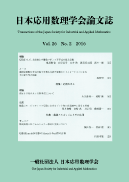
- Issue 4 Pages 269-
- Issue 3 Pages 177-
- Issue 2 Pages 148-
- Issue 1 Pages 1-
- |<
- <
- 1
- >
- >|
-
Hiroyuki Yamagishi, Hiroto Sekido, Yoshinori Kametaka2020 Volume 30 Issue 1 Pages 1-25
Published: 2020
Released on J-STAGE: March 25, 2020
JOURNAL FREE ACCESSAbstract. We consider a classical mechanical model of tetra-, hexa- and octa- polyhedra. Its neighboring two atoms are connected with a linear spring, whose constant is different between the case with Hamilton path and the case without Hamilton path. The discrete Sobolev inequality shows that the maximum of deviation is estimated from constant multiples of the potential energy. Hence, it is expected that the best constant represents the rigidity of the mechanical model.
View full abstractDownload PDF (4118K)
-
Shun Ito, Tomo Tatsuno, Kousuke Kuto2020 Volume 30 Issue 1 Pages 26-44
Published: 2020
Released on J-STAGE: March 25, 2020
JOURNAL FREE ACCESSAbstract. The prey-predator model with the Holling type II nonlinearity is a twocomponent reaction diffusion equations. We construct some time-independent positive invariant sets for this equations when the diffusion coefficients are common to the prey and predator. Namely, there is a region in the phase space where the time evolution stays at any instant as far as the initial condition is within there. These positive invariant sets are constructed from the fact that they coincide with those of the ordinary differential equations which are obtained by omitting the diffusion terms from the original reaction diffusion system.
View full abstractDownload PDF (11323K) -
Jumpei Nagase, Tetsuya Ishiwata2020 Volume 30 Issue 1 Pages 45-70
Published: 2020
Released on J-STAGE: March 25, 2020
JOURNAL FREE ACCESSAbstract. Model design is one of research topics in deep learning. Proposing a better model has been extensively studied, but there is no systematic theory of model design and model structure yet. In this research, we compare the structures of ResNet and DenseNet with a view to systematically understand the skip connection which is one of the structure of the model. As a result, it was theoretically confirmed that it is only due the regularity of full connected layers that gives differences in the expressive power of both models.
View full abstractDownload PDF (2760K)
-
Ryota Ochiai, Takeshi Terao, Katsuhisa Ozaki2020 Volume 30 Issue 1 Pages 71-121
Published: 2020
Released on J-STAGE: March 25, 2020
JOURNAL FREE ACCESSAbstract. Several verification methods have been proposed for linear systems. The verification methods first produce an approximate solution, and next provide its error bound. In this paper, we first set a criterion for an error bound, and next propose a numerical method that produces an approximate solution satisfying the criterion. The criterion is faithful rounding, floating-point neighbors, or rounding to nearest.
View full abstractDownload PDF (4831K)
-
Tatsuro Yashiki, Hiroshi Okuda2020 Volume 30 Issue 1 Pages 122-147
Published: 2020
Released on J-STAGE: March 25, 2020
JOURNAL FREE ACCESSAbstract. To shorten the calculation time of 3D fluid analysis for piping systems, proper orthogonal decomposition method was applied to swirling flow analysis in the piping, and the accuracy of the flow field using the extracted basis space was examined. It was confirmed that the approximation accuracy by using the basis space increases when the number of the Reynolds number and the basis number are increased for both steady and unsteady flows. In the unsteady flow, it was found that number of samples in the direction of time have a small effect on the approximation accuracy by using the basis space.
View full abstractDownload PDF (4404K)
- |<
- <
- 1
- >
- >|